DISCOVERING BORDEAUX

The city of Bordeaux is now such a pleasure to visit and explore, with a rich historic heritage of elegant historic stone buildings, impressive monuments that invite the visitor to stroll along its pedestrian streets, into any number of bistros, Michelin-starred restaurants, wine bars and enticing shops that draw you in. The city today bears little resemblance to the first time we saw it, decades ago now, when the fine stone buildings were grimy, blackened from soot and dirt, shabby and unloved. Seeing the beautiful, creamy stone of the fine city buildings today, it’s hard to imagine its recent past. After many years of hard work, the ‘Sleeping Beauty’ has awoken from its slumber. It’s now a World Heritage Site, and one France’s greatest treasures.
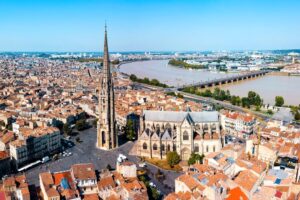
Bordeaux has so many great sites to visit within the city itself. With over 350 historic buildings and monuments, any number of museums and art galleries, the splendid new Cité du Vin and the fascinating Bassin de Lumières to discover, and some of the best food and wine in the entire country–enough to keep even the most energetic visitor busy for a very long time. As well, the city has some outstanding modern buildings, such as the Law Courts, and several vibrant universities, so it’s no wonder Bordeaux is such a drawcard.

A good place to start is with the Triangle d’Or (Golden Triangle) in the Grands Hommes district. This is the city’s most prestigious sector, with its vibrant street life, and outstanding 18th century buildings, with their elegant facades and wide boulevards. It’s where you’ll find, on the Allées de Tourny, luxury boutiques, some of Bordeaux’s finest restaurants, and performance halls such as the Grand Théâtre on Place de la Comédie, one of the outstanding symbols of the city. It stands on the site of a former temple, Les Piliers de Tutelle, that was once in the middle of a Gallo-Roman forum. Designed in the early 18th century, it was originally a theatre, but in 1871 it served as the National Assembly for the French Parliament during the Franco-Prussian war. Today it’s the home of the National Opera and Ballet of Bordeaux. Along with the opera houses of Versailles and Turin, the Grand Théâtre has one of the most beautiful 18th century concert halls in the world.
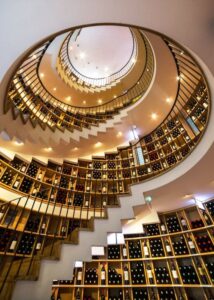
Before you head off from here, check out L’intendant wine shop just across the street from the Grand Théâtre. It’s a very beautiful wine shop with more than 15,000 bottles in stock, stacked on shelves that encircle a 12m high spiral staircase. One look will show you it’s truly “wine heaven”, and the perfect place to buy one or two of the famous wines of the region.

A short walk from the theatre you’ll find the Esplanade des Quinconces, which, at 12 hectares, is the largest city square in France and one of the biggest in Europe. It regularly hosts various fairs, in particular the antiques fair, held in April and November. It’s also home to the beautiful Girondins monument, which was erected in memory of the members of the political movement of the same name, who were killed during the Revolution. This gigantic monument is covered in remarkable statues and sculptures. Just across from here, close to the river, there are two columns topped with statues dedicated to Bordeaux’s maritime and commercial activities.
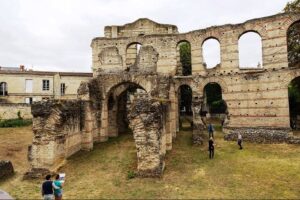
About 10 mins. walk from the Place des Quinconces is the Palais Gallien on rue du Colisée, a former amphitheatre built in the 2nd century CE that once held over 20,000 spectators. It’s the only remaining public monument from the Roman city of Burdigala, which pre-dates Bordeaux. It’s thought that it had perished during one of the many raids by the Franks on Gaul towards the end of the 3rd century CE.
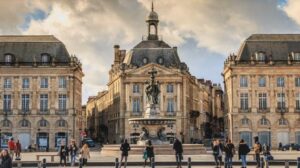
The riverside Place de la Bourse is perhaps the most identifiable landmark in Bordeaux. The construction of these buildings in the 18th century marked the beginning of the end of medieval Bordeaux, which until then, was locked within its walls for centuries.
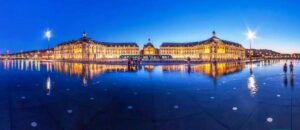
The Hôtel des Fermes and the Hôtel de la Bourse with the pavilion between them, broke through the walls, and created a royal square. Originally, it was separated from the river by gates that were demolished during the Revolution. In the centre of the square, the equestrian statute of the king was replaced by one of Napoleon, and that was replaced by the current Fountain of the Three Graces in 1869.

The Place is probably the most photographed landmark in the city, with its famous Miroir d’Eau, or Water Mirror, built less than 20 years ago. The rhythmic changes in the 2cm of water has been laid on a gigantic slab, and alternates from a glass-like mirror effect to artificial misting. It’s quite magical, and we love watching people coming and going across this square, darting through the misting jets and seeing young children peering at their reflections and splashing about in the water with such exuberance! It has been listed as a contemporary World Heritage Site by UNESCO.
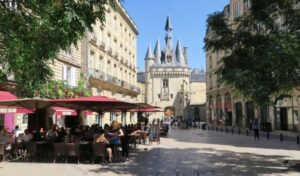
Another must-see historic monument is a former defensive gate, the beautiful Porte Cailhau at the Place du Palais. Dating from 1494 and 35m tall, it was integrated into the city walls, and built to commemorate Charles VIII’s victory at Fornovo, Italy. When you walk through the arch of this tower, keep an eye out for the niche on the river side that asks visitors to pay attention to the lintel, and reminds them that Charles VIII died from walking too quickly into just such a lintel. It pays to stroll—and watch out for low lintels! There’s a great view from here of the oldest bridge in Bordeaux, the Pont de Pierre.

Right in the heart of the city is one of the oldest belfries in France, the Grosse Cloche, which, like the Place de la Bourse and the Porte Cailhau, is one of the most recognisable landmarks in Bordeaux. It was built into the defensive walls in the early 15th century on the site of an older gate. The bell was cast in 1775 and said to weigh 7,750 kilos! It used to ring whenever there was a fire or a storm approaching. Nowadays, it rings on the first Sunday of each month at noon, and on important annual days, such as 14 July. The gateway where the bell is hung also had a defensive function and served as a prison. The gateway is open for visits, and a guide will show you the strange dungeons that locals say are haunted.
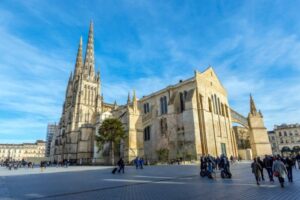
Like every city in France, Bordeaux has its own magnificent cathedral. Cathédrale Saint-André was built between the 12th and 14th centuries, although the oldest section dates from 1096. One of its most unexpected features is its freestanding belltower. The 13 year old Eleanor of Aquitaine and Louis VII, the future king of France, were married here in 1137, as were Anne of Austria and Louis XIII. The cathedral suffered the indignity of being used to store fodder during the Revolution, and suffered from a devastating fire in the 19th century. What we see today is the result of the restoration following that fire.

For a change of pace, and perhaps a little retail therapy, Bordeaux boasts the longest shopping street in Europe. Right in the heart of the city and extending over a kilometre, from the Grand Théâtre to the Place de la Victore, rue Sainte Catherine is not only one of the oldest streets in the city, but also one of the most pleasant. It has existed since the Middle Ages, but it was really from the 18th century that it became one of the most important streets in the city.
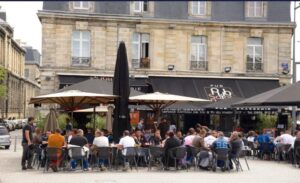
Originally, it was mainly inhabited by craftsmen and traders, but over time, the street became more and more commercial, with shops of all kinds taking up residence. There’s a very good branch of Galeries Lafayette department store in the street at no. 11-19.
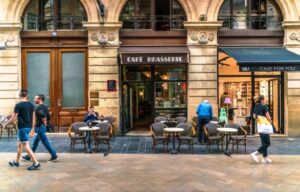
Ranging from big name designer labels to small, independent local boutiques, rue Sainte Catherine is a must-visit for shopping enthusiasts. The street is also known for the numerous good quality souvenir shops, with original gifts to take home. As well, you’ll find all types of restaurants, cafes and bars, where you can taste many different types of dishes, from traditional French cuisine to more exotic flavours. Rue Sainte Catherine will delight not only shopaholics but history fans, as well as those simply looking for a great place to enjoy a stimulating, lively atmosphere.
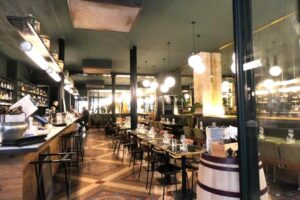
Bordeaux has a number of great places to sit and watch the world go by while enjoying a coffee or glass of local wine. It’s just a matter of deciding which one speaks to you.
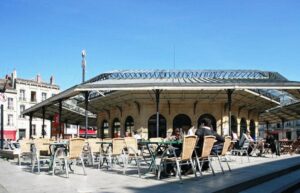
One area to check out is the Chartrons district, slightly to the north of the CBD and in the same neighbourhood as the Cité du Vin. In the heart of the neighbourhood is the Place du Marché des Chartrons. The market hall has become a cultural space, and there are restaurants all around it, which have extended their terraces into the square. It’s a friendly, lively place, with locals enjoying the convivial, relaxed atmosphere, with the accompanying sounds of laughter and the clink of glasses.
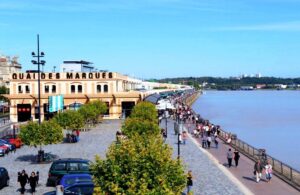
There are pretty terraces all along the Quai des Chartrons, and even closer to the river Garonne, on the Quai es Marques, where you can relax in a deckchair or sit in a riverside cafe and watch the life on the river glide by.
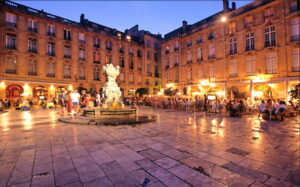
On the southern side of the CBD is the Saint-Pierre district where you’ll discover more relaxed terraces attracting a cosmopolitan clientele. One such popular haunt is Place Camille-Jullian, a place where people of all styles and ages like to rub shoulders. Similarly, the Place du Parlement, not far from Place de la Bourse, is just as inviting. If you want to enjoy an evening drink, a snack or indulge in a long, languid brunch, Place du Parlement is the place to be. You’ll find the entire Place lined with enticing cafes and restaurants, that are clear favourites with the locals.

A little further south you will come across Place du Palais, close to the Porte Cailhau gate. The Place has a somewhat unique triangular shape lined with restaurant terraces. It’s a calm and friendly pedestrian gem, a little off the beaten path from the busy centre of town. A few streets further on, via rue Sainte-Colombe to Place Fernand Lafargue, formerly the Place du Vieux Marché. Once lined with a myriad stalls, it was renovated in 2004 and has been transformed into one of Bordeaux’s trendiest hipster haunts with many attractive shops, restaurants and bars. Lots of choice for lunch, or a simple ice-cream, a delicious dinner, or a nightcap, you’ll find it all here at any time.

Pop into the Tourist Office to enquire about visiting some of the famous wine chateaux in the area. Ask about the Route des Chateaux in nearby Medoc, which is a magnificent wine trail around 80 kms along the D2 road, that combines nature, history and culture on one beautiful road. The Medoc wine region consists of 8 appellations: Médoc, Haut-Médoc, Margaux, Pauillac, Saint-Julien, Saint-Estèphe, Moulis and Listrac-Médoc. May is probably the best month for this, and although two days is ideal, you can do it as a day trip from Bordeaux. The Tourist Office will also have info. about the local companies that do guided tours for a day or half a day. The office is open 7 days a week.

This is just a sample of what beautiful Bordeaux has to offer, and it’s a nice thought that you can never see it all in one visit. One suggestion I would make is that you consider purchasing a Bordeaux CityPass, which gives you free access to a number of museums and monuments, entry to La Cité du Vin prior to 12pm, and unlimited use of Bordeaux’ public transport network during the duration of your city pass. The cost is 34 Euros for 24 hrs., 44 Euros for 48 hrs., or 50 Euros for 72 hrs. Enquire at the Tourist Office, which is very conveniently located at 12, Cour du 30 Juillet, just across the street from where the city’s buses are located, opposite Quinconces city square, and a few paces from the Grand Théâtre.
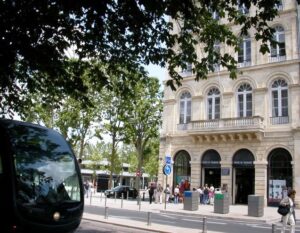
The city’s extensive and very efficient tram network makes it easy to explore many different neighbourhoods, letting you discover with ease what this vibrant, elegant city has to offer. It also allows you choose a wider variety of accommodation than in the past, when it was essential to be right in the CBD. That is certainly not the case nowadays. There is a very good local bus network that covers towns such as St Emilion, and St Aubin de Médoc, and a number of wine châteaux. Ask at the Tourist Office for details. To head further afield, Bordeaux’s TGV station, Gare de Bordeaux Saint-Jean, is centrally located, offering frequent trains to Paris in 2 hrs., and to Lille to the north, and south to Biarritz on the border with Spain.



Leave a Reply